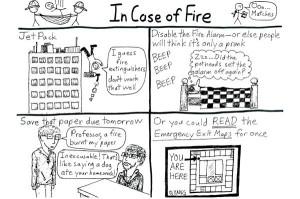Slowly, but with increasing enthusiasm, Smith worked out the math problem. He played with his cornrows, muttered to himself and jotted something down, only to erase it immediately. Finally, he leaned back in his desk, turned to me smiling and triumphantly said, “.3460.” I smiled back with equal excitement and congratulated him with a sincere and emphatic “Yes! Great work!” We were a mere 35 minutes into our math session, but I knew something had clicked – that, somehow, we were working well together, despite being polar opposites.
Smith – whose real name I will not reveal to protect his privacy – is no ordinary tutee. He is an inmate at the Arlington County Detention Facility. He committed a crime, was arrested, tried and sentenced; he is a prisoner. I met him for the first time last Thursday when we had our first tutoring session together, so I know very little about him other than a few details. He is black, 39 years old, is a code-white threat – meaning one of little danger in the prison’s system – and he knows much less about math than most Georgetown students do. Beyond that, I don’t know anything about his past or present situation.
What I can speak to is the man’s personality. He is humble, hard-working and respectful; he has a sense of humor and a certain respect for learning, both of which are extremely admirable qualities given his circumstances.
I can also speak to what he is not: rude, angry, racist, dirty, devoid of compassion or vulgar. He looks forward to our sessions, which supplement his daytime GED classes and are arranged by Georgetown’s Prison Outreach group.
Unfortunately for many men and women like Smith, the majority of Americans never know a prisoner on such a personal level. Instead, they cling to stereotypes that dominate the media. The result is a sort of “Other”-ing effect, one that divides our country into just, law-abiding citizens and the “Others” – monsters who committed evil crimes and have been rightly locked away.
The reality is that their problems are our problems. If we continue to ignore prisoners in jails and ostracize them when they are released, we dehumanize them with devastating effects.
uch has been written about our crumbling prison system: problems with sentencing, overpopulation, gang and racial violence, inefficient spending, rising recidivism rates – the list goes on and on. What has not been said, however, is that what is needed most is a fundamental change in semantics. Our definitions of terms like “crime,”criminal” and “prison” are rooted in societal fears and stereotypes. For example, the connotations associated with “criminal” imply danger at best, evil at worst. How then does Smith stand a chance getting a job upon re-entry into society with a “criminal” record?
A 1999 California study found that of the top four crimes committed that led to imprisonment, three were drug-related. Violent crimes were practically absent from the top 10, while burglary, theft and robbery were the second-most prosecuted offenses. Obviously, there are many former convicts who have committed severe crimes such as murder, and should not be easily trusted. But these statistics demonstrate that there is also an intrinsic problem with our definition of “crime.”
Currently, one in every 31 adult Americans – 3.2 percent of the adult population – is under some form of correctional control, including imprisonment, parole and probation. As of 2008, 13 states allocated more than $1 billion for their corrections systems, and total state spending exceeded $49 billion. These are staggering numbers that should scare us.
The societal repercussions are just as bad. When an individual is locked away, he or she is fundamentally changed by the experience – often for the worse. If one is locked away for one to two years for possession of a controlled substance, for example, one has a much higher chance of committing a more serious crime upon release than they did before. The recidivism that follows is a vicious cycle.
Prisons need to be not only places to punish criminals, but also places to counter the roots of those crimes: lack of education, poverty, abuse and addiction. Our definition of “prison” can no longer be the arcane “house of punishment.” This doesn’t mean we should go “soft” on crime – another enormous error in semantics – but it means that we should correct crime.
Clearly, the problem is multifaceted and complex; it involves education and economics, psychology and sociology, among others. The solution must begin with more accurately defining the world around us. We must reevaluate how we see our fellow men – including individuals like Smith. We must perceive them, not as Others, but as equals in need of help.
Conor Finnegan is a sophomore in the College. His online column, On the Road, appeared every other Monday this semester at www.thehoya.com. He can be reached at finneganthehoya.com.
*To send a letter to the editor on a recent campus issue or Hoya story or a viewpoint on any topic, contact [opinionthehoya.com](opinionthehoya.com). Letters should not exceed 300 words, and viewpoints should be between 600 to 800 words.*”








